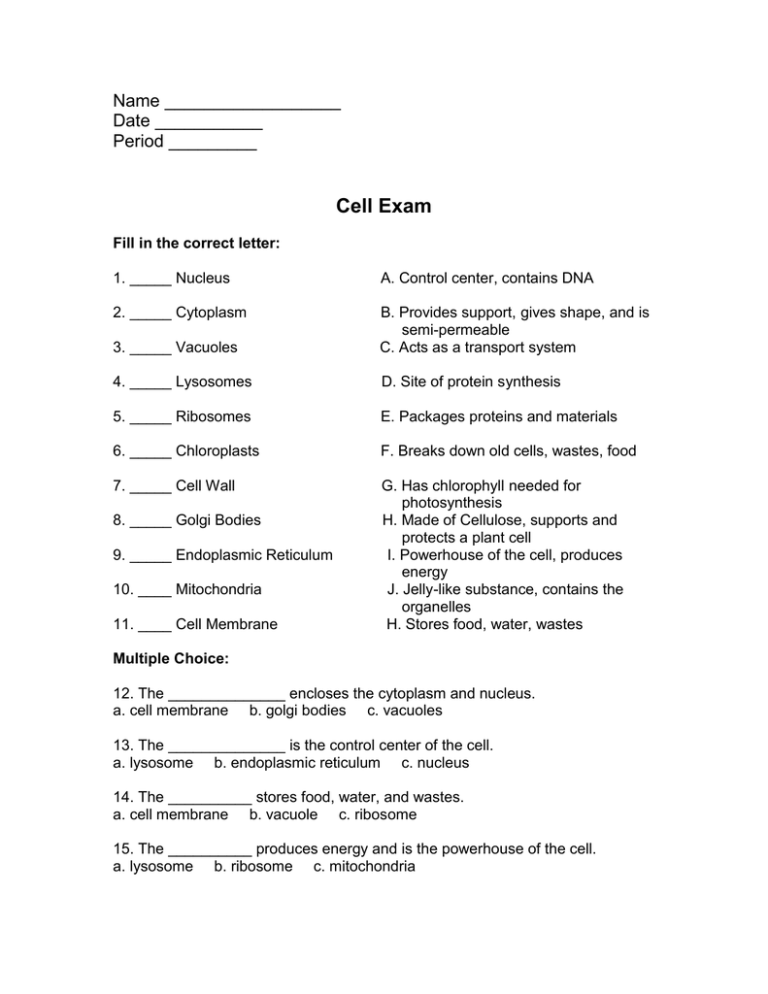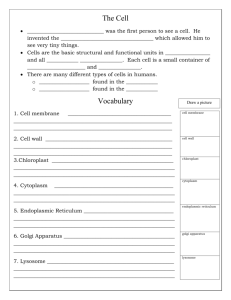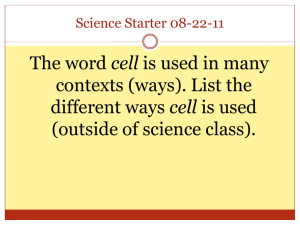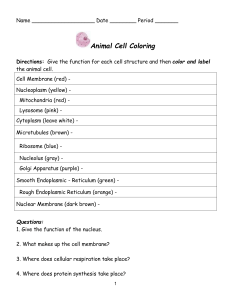Cell Exam Name __________________ Date ___________
advertisement

Name __________________ Date ___________ Period _________ Cell Exam Fill in the correct letter: 1. _____ Nucleus A. Control center, contains DNA 2. _____ Cytoplasm 3. _____ Vacuoles B. Provides support, gives shape, and is semi-permeable C. Acts as a transport system 4. _____ Lysosomes D. Site of protein synthesis 5. _____ Ribosomes E. Packages proteins and materials 6. _____ Chloroplasts F. Breaks down old cells, wastes, food 7. _____ Cell Wall G. Has chlorophyll needed for photosynthesis H. Made of Cellulose, supports and protects a plant cell I. Powerhouse of the cell, produces energy J. Jelly-like substance, contains the organelles H. Stores food, water, wastes 8. _____ Golgi Bodies 9. _____ Endoplasmic Reticulum 10. ____ Mitochondria 11. ____ Cell Membrane Multiple Choice: 12. The ______________ encloses the cytoplasm and nucleus. a. cell membrane b. golgi bodies c. vacuoles 13. The ______________ is the control center of the cell. a. lysosome b. endoplasmic reticulum c. nucleus 14. The __________ stores food, water, and wastes. a. cell membrane b. vacuole c. ribosome 15. The __________ produces energy and is the powerhouse of the cell. a. lysosome b. ribosome c. mitochondria True or False: 16. _____ The cell wall provides support for the cell. 17. _____ Vacuoles transport materials throughout the cell. 18. _____ The mitochondria is known as the powerhouse of the cell. 19. _____ The cytoplasm is known as the brain of the cell. 20. _____ Endoplasmic Reticulum stops materials from moving throughout the cell. Short Answer: 21. Who were Robert Hooke, Thomas Schleiden, and Matthias Schwann? What are they responsible for? What was important about their discoveries? ________________________________________________________________ ________________________________________________________________ ________________________________________________________________ 22. What are the three parts of the Cell Theory? ________________________________________________________________ Using the Word Bank provided, Label the diagram of the Cell. Nucleolus Endoplasmic Reticulum Chloroplast Cell Membrane Nucleus Cell Wall Cytoplasm Nuclear Membrane Golgi Body Ribosome Vacuole Mitochondria 32. Compare and contrast a Plant and Animal Cell. Number and Label the parts of the Microscope. 33. Arm 34. Base 35. Eyepiece 36. High Power Objective 37. Low Power Objective 38. Nosepiece 39. Body Tube 40. Coarse Adjustment Knob 41. Fine Adjustment Knob 42. Stage 43. Stage Clip 44. Diaphragm 45. Mirror





